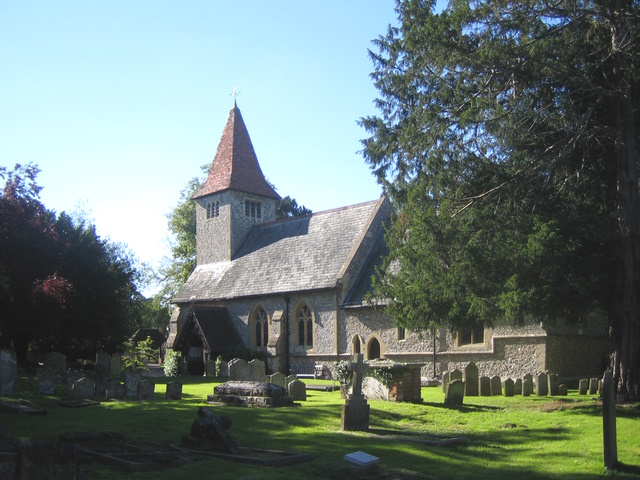


























All Saints Church, Rotherfield Peppard
The medieval All Saints Church in Rotherfield Peppard was heavily restored in 1875, resulting in a plain building of stone and flint with a slate roof. The present church has a two-bayed chancel and a four-bayed nave with a three-bayed north aisle. The gabled south porch is timber-framed with decorative barge-boards, and the stone and flint bell tower with tiled roof is supported from within the west end of the nave. A vestry was added at right angles to the north side of the chancel in 1965, while a parish room (built 1981–2) adjoins the west end of the north aisle at an angle. A few pieces of 12th-century stonework survive in the chancel, notably two Norman windows on the north side and one on the south, with internal roll sill-moulding. During the 1875 restoration, the outer jambs with scalloped capitals and the springing of two arches of a Norman arcade were discovered flanking the east window, variously interpreted as the remains of blind arches or of windows blocked during the 14th century. The pointed chancel arch on Romanesque shafts with carved capitals is of early 13th-century design, suggesting that the church was extended at that date. The Norman font, of Corallian freestone from Wheatley, is tub-shaped with a band of cable-moulding. The medieval chancel was re-roofed by William Cheshire (rector 1562–87), while in 1759 orders were issued to repair the roof tiles and various internal furnishings. In the early 19th century the church was said to be 80 feet (24 metres) long and 20 feet (6 metres) wide, in good repair, and able to seat 150 people. It was described as 'a neat and rather spacious structure with a wooden turret. The walls are whitened on the outer side, and gain much pictorial effect from a partial but umbrageous screen of ivy'. Robert Prichard (rector 1808–48) repaired and re-roofed the chancel c. 1830, and his successor Henry Reynolds (rector 1848–70) agreed that the church was in good condition. However, in 1872 Thomas Williams (rector 1870–81) described the church as 'in tolerable repair but very shabby', and was already seeking funds to remove the 'tall white pews with vast pulpit' and to restore the choir In 1874 plans for a more thorough restoration were well advanced. An appeal for funds described 'the serious state of dilapidation into which Peppard church has fallen from age and decay, the perished state of much of the woodwork, and the consequent dangerous condition of the gallery and bell turret'. About £700 of the estimated cost of £1,600 was still wanting when work began. The architect, William Scott Champion, proposed to remove the gallery and rebuild the wooden bell turret, to add a new roof, new floor and new seats, to insert new windows in the nave and at the east end, to build a north aisle, and to add a vestry at right angles to the south side of the chancel. Much of this work was carried out during 1875, although neither vestry nor bell turret were built because of a lack of funds. A temporary wooden belfry was constructed at the west end of the nave, until plans for a new tower (under discussion by 1905) were adopted in 1908. The original plans of the architect, Edmund Sedding, which included room for a vestry at the base of the tower, were not accepted. Instead a separate vestry was proposed adjoining the west end of the north aisle and extending beyond the west end of the nave. The tower was built first, the cost met by subscriptions and grants, although the rector insisted that the new vestry (built in 1909) should take precedence over the addition of a clock and the hanging of the bells. The tower was erected by local builder Charles Butler, and funds were needed for its repair in 1930. The present porch was also built in 1908. A separate clergy vestry, built in 1965, was the gift of a local resident. The choir vestry of 1909 was replaced by a parish room in 1981–2 at a cost of £38,000, met by general fund-raising. The church was redecorated in 1960, and repairs to the exterior were carried out in 1985 and during the 1990s, including re-slating the chancel roof. The lychgate at the entrance to the church, of oak on brick foundations with a tiled roof, was built in 1938. Historical information about All Saints Church is provided by 'Rural Parishes: Rotherfield Peppard', in A History of the County of Oxford: Volume 16, ed. Simon Townley (Woodbridge, Suffolk, 2011), pp. 302-337. British History Online http://www.british-history.ac.uk/vch/oxon/vol16/pp302-337 [accessed 28 March 2023]. All Saints Church is a Grade II* listed building. For more information about the listing see CHURCH OF ALL SAINTS, Rotherfield Peppard - 1369298 | Historic England. For more information about All Saints Church see Rural Parishes: Rotherfield Peppard | British History Online (british-history.ac.uk). |

